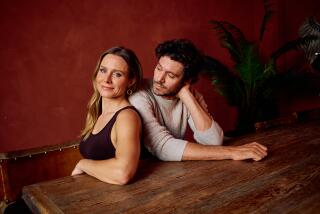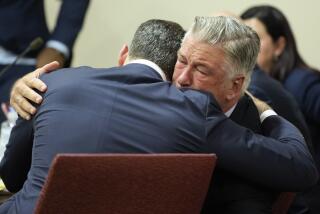Two Pictures of Broderick Painted; Case Heads to Jury : Murder trial: Was it a ‘double execution’ or was the La Jolla socialite at the ‘mercy of her emotions?’
- Share via
SAN DIEGO — Calling it an “ambush” and a “double execution,” a prosecutor said Wednesday that La Jolla socialite Elisabeth Anne (Betty) Broderick fully intended to kill her ex-husband and his new wife because she crept into their bedroom while they slept and “blew them away.”
In a summation that the defense said badly miscast Betty Broderick’s emotional state, Deputy Dist. Atty. Kerry Wells said the killings were the culmination of years of planning and a “smoldering, constant hate” for her ex-husband, prominent lawyer Daniel T. Broderick III.
When the “time was right”--after their four-year divorce was over, when Betty Broderick had nothing left to gain in the courts and needed again to be the “center of attention”--she killed him and his new wife, Linda Kolkena Broderick, Wells said.
Urging the jury to return two first-degree murder convictions, Wells said, “You do not point a .38-caliber gun loaded with hollow-point bullets at two people lying in a bed only inches away, early in the morning, and fire without intending to kill them.”
Betty Broderick, 43, is charged with two counts of first-degree murder in the Nov. 5, 1989, deaths of her ex-husband and his second wife. She could be sentenced to life in prison without parole.
The case, which has aroused extraordinary attention in San Diego, drew an overflow crowd Wednesday to the county courthouse that included civics students from El Cajon Valley High School.
Defense attorney Jack Earley said Wednesday that, as Betty Broderick testified, she did not intend to kill anyone but herself that morning. She sought only to talk to Daniel Broderick when she stole into his house, then crept into his bedroom before dawn, Earley said.
Daniel Broderick, who was 44, was a leading medical malpractice lawyer and a former president of the San Diego County Bar Assn. Linda Broderick, who was 28, was his office assistant.
After 16 years of marriage, Daniel and Betty Broderick separated in 1985. During their bitter divorce, which was not final until 1989, she accused her husband of cheating her out of her fair share of his seven-figure annual income.
The Brodericks’ bitter divorce had made her feel “immense emotions” of anger, rage and depression, Earley said. Betty Broderick stepped into the bedroom and encountered another rush of emotion because, for the first time, she saw her ex-husband in bed with his new wife, he said.
She fired her gun, but not in a cold and calculating way, Earley said. Instead, she was at the mercy of her emotions, “out of control,” like a “boat without a rudder,” he said.
“Her act was one of craziness, one of emotion, one that should never have happened,” he said.
Both lawyers were emotional themselves during their closing arguments, raising their voices often and gesturing frequently to the jury. Betty Broderick, however, wrote notes to her attorney and, for the most part, sat impassively with her chin in her hand, looking away from the jury.
San Diego Superior Court Judge Thomas Whelan said he would instruct jurors today on their five options in the case--first- and second-degree murder, voluntary and involuntary manslaughter, and not guilty on any charges. After the instructions, jurors are due to begin deciding the case.
Though Whelan had said earlier that he was not sure whether to offer the option of voluntary manslaughter in the death of Linda Kolkena Broderick, he said Wednesday that he would offer it. Provocation is the key to voluntary manslaughter and, according to the defense, Linda Kolkena Broderick frequently had provoked Betty Broderick.
First-degree murder means the killing was premeditated--or considered beforehand--while second-degree lacks that deliberation. Voluntary manslaughter means a killing was committed after a sudden provocation. Involuntary manslaughter describes a killing that occurs while doing something else without due caution.
Earley did not suggest to jurors which level of liability was the correct one in the case. He said only that they should make the “right decision,” keeping in mind the emotional turmoil that Betty Broderick found herself in after the nasty divorce.
Wells, however, was unequivocal.
“The law,” she said, “does not allow a person to charge into other people’s homes with a loaded gun, to confront them, catch them totally off guard, unprotected, helpless, and kill them both, and then say, ‘But gosh, I didn’t really mean it. I shouldn’t be responsible.’ She’s responsible for murder, period.”
Betty Broderick’s claim that she wanted to confront her ex-husband was “hogwash, absolutely hogwash,” Wells said. “There was no way she truly expected Daniel Broderick to talk to her about the divorce after being confronted at 5:30, 6 in the morning in his bedroom.”
If she did want to confront him, Wells said, why, before she fired, didn’t “she say, ‘Hold it, I want to talk to you’? Why wasn’t there a confrontation if she wanted a confrontation?”
Defense lawyer Earley maintained that Betty Broderick assuredly did have the intent to commit suicide in the bedroom, saying that a suicide sparked by a divorce is not uncommon. But Wells said “there was no way” Betty Broderick contemplated suicide.
“If she did that, clearly Dan and Linda would have won,” Wells said, since Betty Broderick “knew that’s what they wanted.”
For years, Wells said, Betty Broderick had threatened to kill her ex-husband and his new wife--leaving a threat in a message on his answering machine in 1986, confiding in a court mediator in 1987, scrawling in a diary in 1988 and telling a housekeeper in 1989.
In 1987, she even told one of the couple’s four children that she “hated Daddy” and wished “he’d just die.”
In that conversation, taped between Betty Broderick, and her son, Danny, then 11, she repeatedly called Daniel Broderick and Linda Kolkena vulgar names. Other testimony at the trial showed that Betty Broderick had left numerous messages on her ex-husband’s machine in which she routinely called him and Linda Kolkena obscene names.
The tape with Danny, Wells said, truly revealed not only the “essence of Elisabeth Broderick” but the “essence of the entire case,” showing her to be “selfish and cruel,” even to her children, Wells said.
In March, 1989, Betty Broderick bought a gun, according to testimony. To believe that, after all the threats, the killings seven months later were the product of a sudden and rash impulse required a belief in Betty Broderick’s testimony, Wells said.
But Betty Broderick, Wells said, was the “most incredible uncredible person you will ever come across in your life.”
Repeatedly, Betty Broderick changed her story about where she found the keys she used to enter Daniel Broderick’s house, saying variously that she found them, her maid found them or she didn’t know where the keys--which belonged to her eldest daughter, Kim, 20--came from.
“She’s awfully selectively forgetful,” Wells said.
Earley, however, said the keys made no difference in the case, since, wherever they came from, they proved only that Betty Broderick had the intent to enter her ex-husband’s house on Nov. 5 and no more.
Like the keys, Wells’ focus on the vulgar messages Betty Broderick left on her ex-husband’s answering machine was misguided, Earley said, because they did not prove an intent to kill.
As for the vulgar names, he said, “I don’t even think that in the case of 2 Live Crew there was more time spent on those issues than in this court,” referring to the rap group acquitted last month in Florida of obscenity charges.
There was “no good excuse” for Betty Broderick’s conversation with her son, Danny, Earley said. But there was “no reason for the jury to look at it and make a moral judgment and, based on that moral judgment, say she should be convicted of a crime,” Earley said.
Since Daniel Broderick made the tape--intending to use it at the divorce trial--instead of comforting his son, the more important issue, Earley said, was what the tape said “about a man who hears that distress but says, ‘My job as a lawyer, making cases, overrides any other concern I have.’ ”
Other planks in Daniel Broderick’s case against his ex-wife involved telling her she was crazy, calling her fat and ugly, keeping her in suspense about weekend visits with the children, and repeated contempt citations during the divorce case, Earley said.
Earley said that Daniel Broderick was the one who embarked on a campaign--a plan of “crazy-making behavior”--that left his ex-wife in “the throes of emotions.”
Betty Broderick admits firing the fatal shots, Earley said. But “there was no premeditation and deliberation in this case. This was not the act of someone who wants to be the princess and the victim.”
More to Read
Sign up for Essential California
The most important California stories and recommendations in your inbox every morning.
You may occasionally receive promotional content from the Los Angeles Times.













